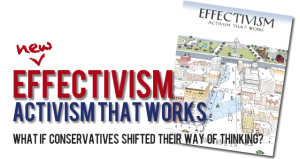Blog
What if conservatives shifted their way of thinking?
March 15, 2013
We’ve all seen a hamster on a wheel, exercising, spinning endlessly. It’s a blur of activity—and goes absolutely nowhere. Consider then a construction crew building a house: they are also active, but in the end there is a successful product—a home. The building is evidence that, with a systematic, purposeful approach and a goal in mind, there can be a meaningful end to your efforts.
Many conservative activists fall into the habit of showing up with no real purpose in mind. They get involved in tasks and groups that don’t actually bring success. Forwarding emails, attending conferences with like-minded people, or periodically rallying ad nauseam on the steps of a state capitol makes people feel like they’re accomplishing something—and it changes nothing. Like the hamster on the wheel, there is motion as conservatives churn away, but they get nowhere.
 What if conservatives shifted their way of thinking? What if they created their own blueprint and became the architects of their own work—instead of simply following the plans of others? What if they found specific purpose and targeted a goal? Then their activism would become truly effective, and they would become effectivists (effective + activist = effectivist). Instead of simply sending along those emails, activists could become effective Wiki contributors, fighting the information war online. Instead of going to rallies on Saturdays, effectivists could canvass and hardwire political precincts. Think of the number of registered voters you could locate if they spent weekends in their own neighborhoods instead of boarding a bus to D.C.
What if conservatives shifted their way of thinking? What if they created their own blueprint and became the architects of their own work—instead of simply following the plans of others? What if they found specific purpose and targeted a goal? Then their activism would become truly effective, and they would become effectivists (effective + activist = effectivist). Instead of simply sending along those emails, activists could become effective Wiki contributors, fighting the information war online. Instead of going to rallies on Saturdays, effectivists could canvass and hardwire political precincts. Think of the number of registered voters you could locate if they spent weekends in their own neighborhoods instead of boarding a bus to D.C.
Politics: A Contact Sport
Ever see that Science Channel show called “How It’s Made”? It’s amazing how they actually make the sweet stuff we eat. I mean, really, who was the first guy who figured out those giant factory schematics—all to churn out chocolate in different sizes and shapes?
An Offer They Can’t Refuse
Politics is no different. It looks complicated but you don’t need a camera crew to wade hip-deep into your local or state government. Turns out most of those musty old civics books were correct—governing bodies are structured very similarly across the country. It’s up to you to pick your point of entry.
Ever tried to call your congressman in D.C.? How did that go? You may not realize it, but you can have much more impact reaching out to your local office-holders than your higher-ups. It may seem like a small thing to buttonhole your polyester-clad city councilman or speak with that serious lady who sits on the school board. Yet folks at these lower levels have tremendous say over how literally millions and millions of your tax dollars are spent.
Don’t believe it? Check out the checkbook of your average county executive (who is unelected in many instances), or unearth the percentage of your annual local budget that is mandated to be put into “education” (70% sometimes). It adds up.
The good news is that you can get to these people. No, not in a Mafioso-type way—but you can and should seek them out wherever possible. Put monthly meetings and public hearings on your calendar. You have to be deliberate, but it’s not difficult to locate those much vaunted public servants and give them a piece of your mind, or even just observe them at work.
You have been reading an excerpt from “Effectivism: Activism that works,” an American Majority Activist Training Manual. Want more? Check out our list of Activist Trainings or invite us to do a training in your community!
